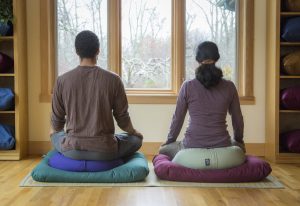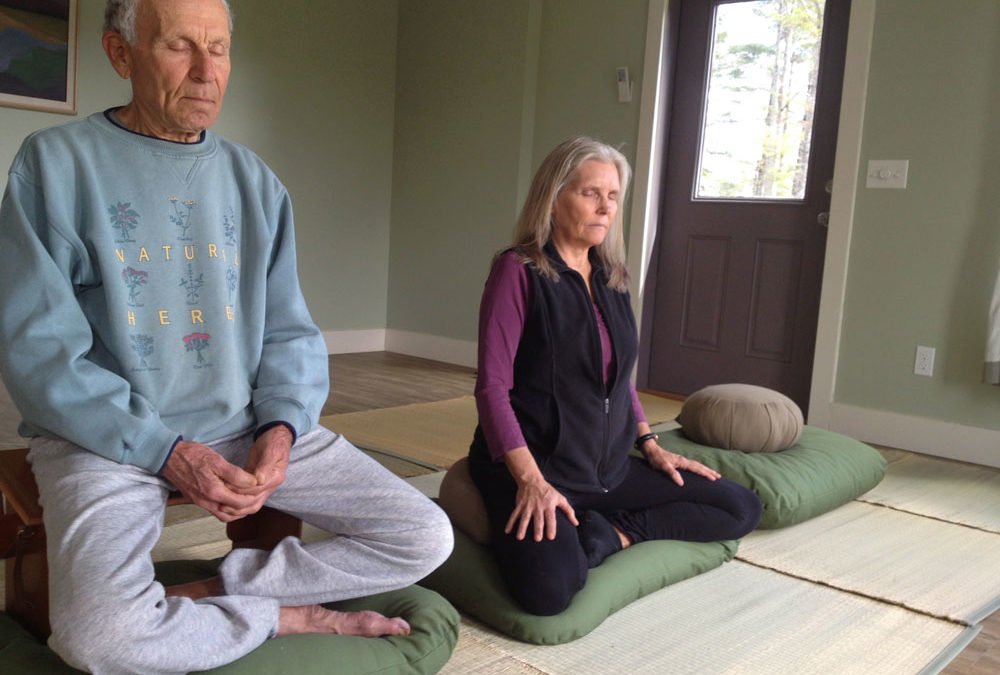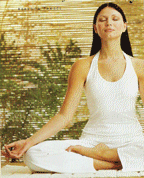A meditation cushion or bench puts you in a relaxed but alert position where breathing, circulation, and life energy (a.k.a chi, prana, shakti or kundalini) flow optimally.
We recommend three basic positions:
1–Sukhasana (a.k.a Easy Pose and Perching)–usually using a Sky Bench™ or Tilt Seat™— is an asana similar to sitting in a simple cross-legged position. While opening the hips and lengthening the spine, the posture’s relative ease on the knees makes it easier than Siddhasana or Vajrasana for people with physical difficulties or limited flexibility.
2–Siddhasana (a.k.a. Burmese)–traditional cross-legged position–usually using a Zafu or Smile Cushion™.
3–Vajrasana (a.k.a Seiza or Kneeling)–usually using a Peace Bench™.
However, other positions are appropriate for some situations. The lounge position or Shavasana (laying flat) can actually be better at times when you are too tired to sit. Eco Backrest™ can be the perfect lounge chair for those times.
The positions are not necessarily product-specific, although certain products lend themselves to specific sitting methods.
Each person is built differently and will find her or his own individual meditation seat or combination of seats. Many people prefer to alternate between different sitting positions and different seats.
Sukhasana (a.k.a. Burmese and Cross-legged)
The legs are crossed in front, with the knees on the mat, and one foot in front of the other. This position offers the most stability, with three points touching the ground or cushion, creating a tripod effect.
The Smile Cushion™ is the most popular–and most ergonomically suited–cushion for this position. However, the Zafu is the traditional cushion for this. A Peace Bench™ works well for this too, if the bench is one size smaller than the size used for kneeling. This position is similar to the ‘lotus position”, of yogic origin. However, the lotus position can create stress on the knee joints and cause damage from cumulative effect. Sidhasana generally requires more flexibility than the other two positions, but is also more stable. If you desire to sit this way but don’t yet have the flexibility, we recommend starting with the Sukhasana. Gradually your leg and hip muscles will loosen and you will be able to ease into the true Burmese Position, with knees all the way down on the mat. This process can be enhanced by starting a gentle stretching routine for legs, hips and back. If taking this approach, you will probably need a support cushion to provide extra height for the sky position.
-
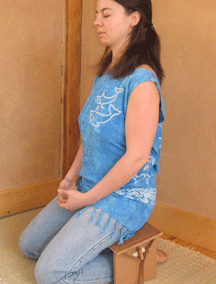
The Kneeling Position (a.k.a. VIJRASASA and SEIZA) on a Peace Bench™
-
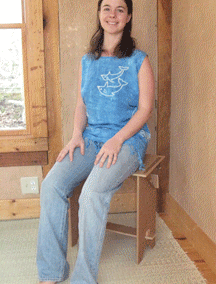
Sitting on Tilt Seat with feet in front.
-
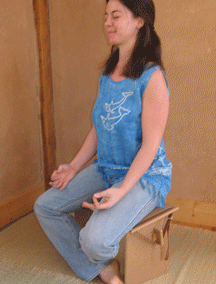
The SKY POSITION on a
SKY BENCH™
-

SHAVASANA or Lounge Position on the YOGA LOUNGE™
-
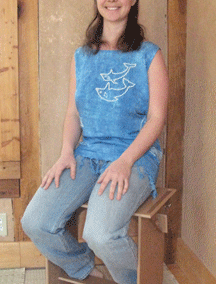
Sitting on Tilt Seat™ with feet in back ankles resting on lower bar.
-
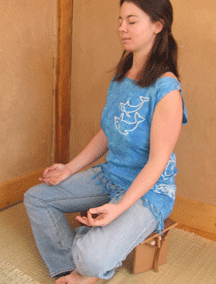
The SKY POSITION on a
PEACE BENCH™
-
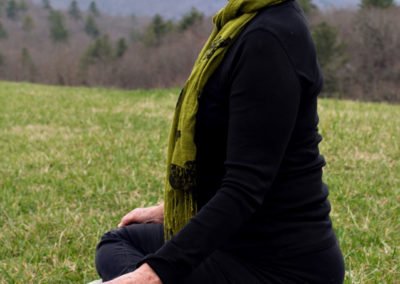
Sidhasana using a Zafu
-
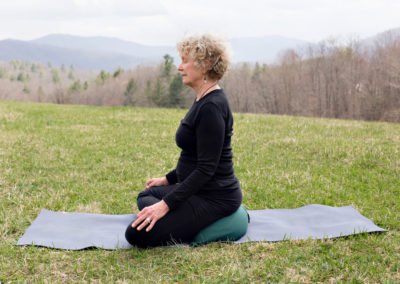
Sidhasana using a Smile Cushion™
Vijransana (a.k.a Kneeling and Seiza)
The Peace Bench™ is normally used for this. A zafu or smile cushion™ turned on the side also works. Some people even prefer placing a zafu on top of another zafu and kneeling like a saddle, or alternatively, a smile cushion placed with tips facing down, with a support cushion under it.
Generally, the Kneeling Position requires less flexibility than the Burmese Position.
Sukhasana (a.k.a Perching and Easy Pose)
The knees are in the air–yet lower than the hips. This is a hybrid between the cross-legged and kneeling positions. This position is useful especially for those of us with limited flexibility.
The sky position requires a higher seat. If using a Smile Cushion™ or Zafu, place a Support Cushion under it to raise the height. Some people place one Zafu on top of another and find a good height that way. Others use a Peace Bench™. For this, a person would need a bench one size taller than the one they would use when kneeling.
The Tilt Seat™ also achieves this perching effect, and has the advantage of being at the height of a regular chair.
The lounge position (Shavasana)
This position is used for complete relaxation and resting of the back. This position is excellent when one is too tired to meditate sitting up. It can also be used for eating, reading, and laptop computer.
Meditation Seats Compared
1–If you like sitting in the cross legged (Burmese) position then you are probably better off with a Smile Cushion™. The Smile Cushion™ provides more surface area for your tush, which helps alleviate legs falling to sleep. The weight extends beyond the buttocks down the thighs. The Smile also provides more height than any other cushion we offer–if you want it. (Remember the height is adjustable). See below for a discussion of the different stuffing options.
2–If you like sitting in a kneeling position, then the meditation bench (Peace Bench™) is most suited for that. Meditation Benches or Seiza Benches, provide a way to sit in meditation posture without sitting cross-legged. Some people have problems with the type of leg stretching and flexibility required for sitting cross-legged. We offer four sizes to help you customize your sit. (Note: if you fall on the size cusp and your legs are longer than average for your height, go with the next size up. You need enough room beneath the bench so your ankles do not touch it. A bench cushion is also available separately which velcros securely with straps. This makes the bench experience much more comfortable. Some people like to buy two Peace Benches™–a smaller size for the kneeling position and a size or two larger for the sky sitting position.
3–The “Sky” position is a hybrid between the kneeling and the cross-legged (Burmese) position. The knees are in the air a few inches off the ground, yet lower than the hips. The best seat for this position is either 1) a meditation bench larger than what you would use for kneeling or 2) a smile cushion™ with a smile support cushion under it (to raise the height). Since this position requires less bending of the knees and legs than any other position, it works very well for people with special needs which limit flexibility. It is a perfectly balanced position and can be used by anyone. The Tilt Seat™ puts you in a sky position that is the height of a chair, or a bit higher. This is great for working at a table or computer as or meditating when getting up and down to the floor is an issue.
4–The zabuton (or sitting mat) provides essential cushioning for the knees, legs, ankles and feet. It also holds the cushion or bench more securely which results in a more stable and grounded posture. Many people buy the cushion or bench alone and use a folded blanket or similar cushion beneath in place of a zabuton. This is a good way to test the waters, but is not the best permanent set up. When you are ready for your very own zabuton, it is simply a choice of size. People less than six feet fit on a medium; six feet to six feet two inches use a large; and over 6′ 2″ use our Jumbo version. If you want a little extra room for your knees, order the next size up.
5–The support cushion is placed under the zafu or Smile Cushion™ to provide more height. It also can be used under a knee or placed on the lap to rest the hands on. It is especially useful for larger people needing more height than the zafu or smile provides, or those practicing the sky position.
6–For travel, either by foot, airplane, canoe or camel, the inflatable zafu is by far the easiest way to go. Only six ounces and the size of a paperback book when deflated, this small anomaly has baffled sages for ages. It’s there, but it’s not. What better thing to meditate on? You can have an instant zafu, but can you have instant enlightenment? It can be used in Burmese or kneeling positions. It also is perfect for lumbar support in airplanes, car seats, and chairs, when just barely inflated. It also works as a “wedge cushion” in chairs when barely inflated.
7–Our Tilt Seat is great for those who prefer sitting off the floor, but still have the ergonomic benefits that the floor devices give., which helps extend the good practices of autonomous sitting to other activities like computer or desk work. The Tilt Seat™ also serves as a meditation study table, alter, or reading/writing table. If you sit on a zafu, smile cushion™, or peace bench™, place the tilt seat™ in front of you with the low angle toward you, and place your reading/writing material on the surface.
FILLINGS
Organic buckwheat hull zafus and smiles are like firm beanbags. They move around a bit and conform to your shape, but offer a solid sit. Our buckwheat hulls are 2-3 sided, and each one has a slight spring or yielding quality. They also provide more height because they do not compress as much as kapok filled cushions. With a little effort, the hulls can be removed to machine wash the cover. Some people don’t like the extra weight (about twice as heavy as kapok) and there is a slight crunching sound when first sat on. It is a soft sound like someone walking on gravel and can be considered soothing, like gentle rain or leaves rustling.
Kapok stuffed zafus and smile cushions™ have the consistency of a sleeping bag stuffed into its stuff sack. Kapok is very fluffy when loose, but becomes firm, smooth, and solid when stuffed into a cushion. Kapok is the soft seed pod of the kapok tree and is harvested on plantations in Asia. Kapok fiber is naturally mold resistant and even floats (it is used to make aircraft seats and other flotation devices). Within a few months, a kapok zafu will loose some of its loft. But no problem–just add 1/2 pound of kapok to firm it up to its original height. Placing in the sun on a nice day or in a dryer on low will also fluff it up by extracting moisture.
Which stuffing creates a “softer”, or more comfortable sit? There is no answer to this, because there is no universally accepted definition of “comfort”. One big misconception of “soft” is that if it feels soft to the touch, it will feel soft when sitting on it. This is not true. When sitting, most of the body’s weight should be supported by the sit bones. If the cushion is too mushy, springy, (IE SOFT), there will be too much pressure on the leg muscles/buttocks and thus poor circulation and bruising.
Here is an incredible video demonstrating in detail some of the sitting techniques in this article. http://anmolmehta.com/blog/2007/04/18/free-online-guided-meditation-book-zen-meditation-technique-ch-1/
In reality anything you sit on for a long period of time will eventually seem “hard”. Sitting or Standing or holding ANY POSITION too long can cause repetitive stress injuries. This technique of ‘natural sitting’ can make sitting more comfortable and possible for longer periods of time than a chair, but there are still limits. The reason for this is: the human body is designed for locomotion, not sitting. That’s why we offer so much information and instruction to help you get the most from your sitting experience. When it gets too hard, perhaps it’s time for a walking meditation, or a change of positions.
The good news is, with such a variety of options, we probably have a meditation seat just for you. And we have a great returns policy to help you fine tune your sitting environment.
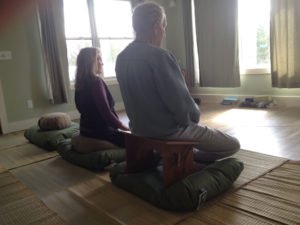



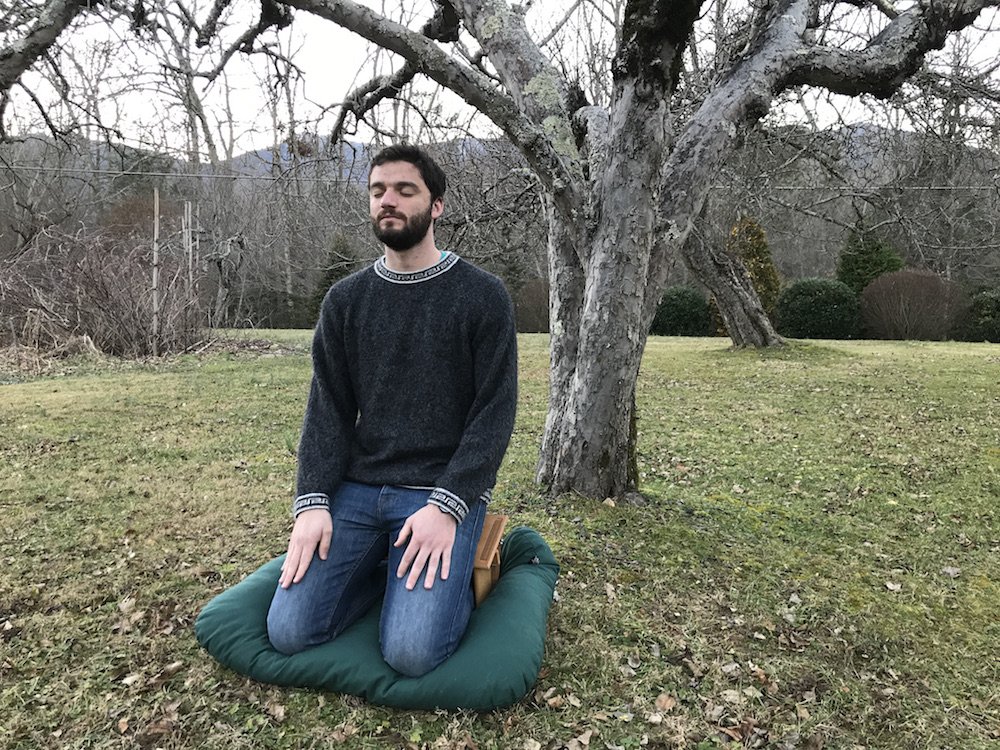
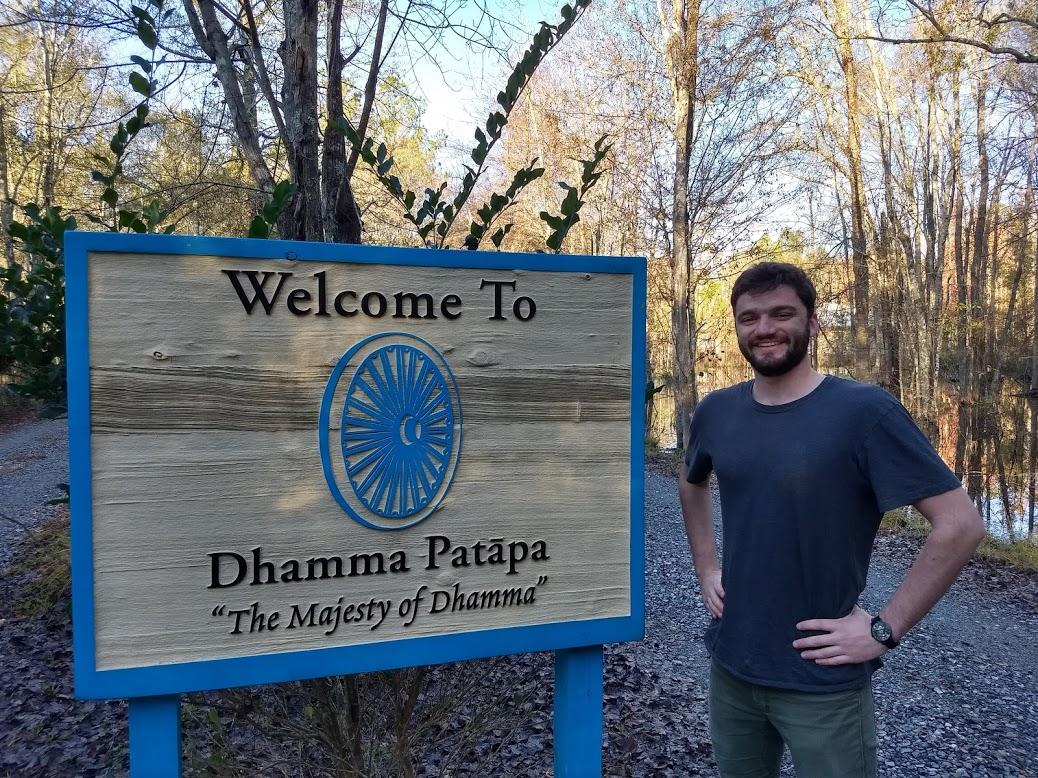
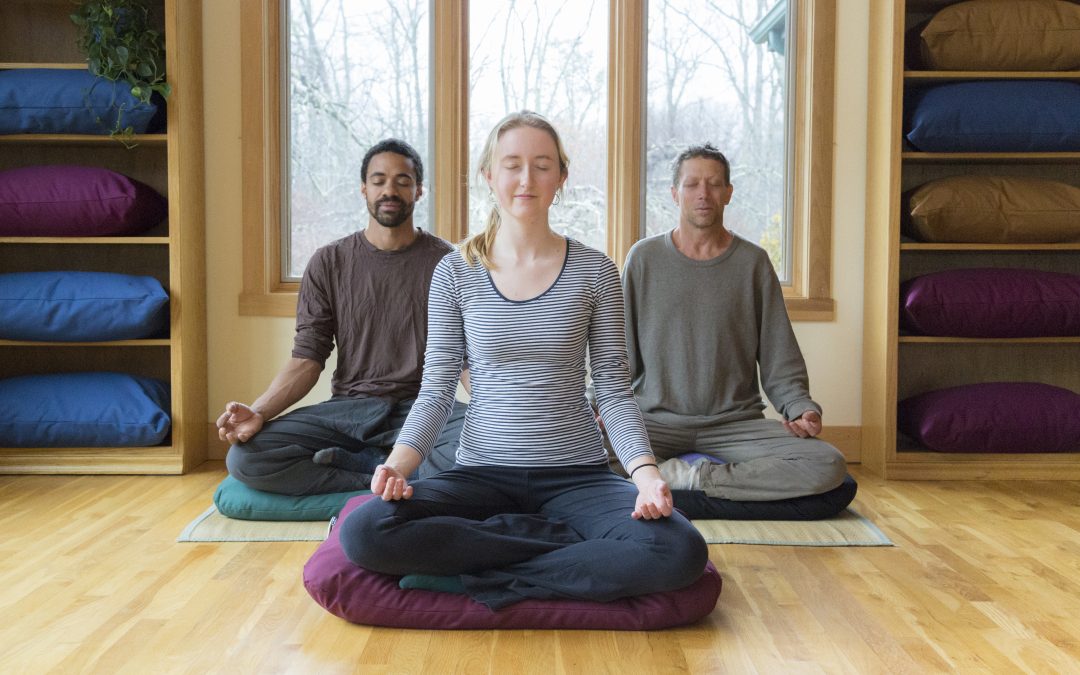
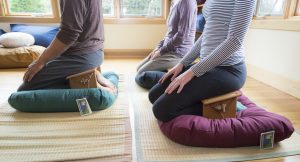
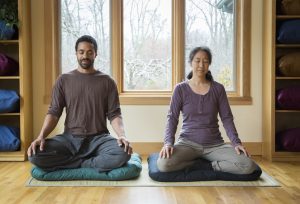 Once you decide where to be with the breath, let this be an anchor, the place you return to again and again. Bring a full mindfulness to the breath: making no effort to control the breath, discover what it is actually like, moment to moment. If the attention gets too tight or tense, relax your body again, soften back into the breath. If the attention becomes spacy, difficult to focus, then intend to bring a real precision and clarity to the awareness of the breath.
Once you decide where to be with the breath, let this be an anchor, the place you return to again and again. Bring a full mindfulness to the breath: making no effort to control the breath, discover what it is actually like, moment to moment. If the attention gets too tight or tense, relax your body again, soften back into the breath. If the attention becomes spacy, difficult to focus, then intend to bring a real precision and clarity to the awareness of the breath.